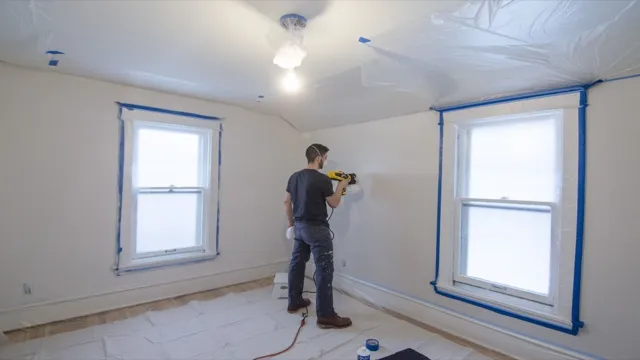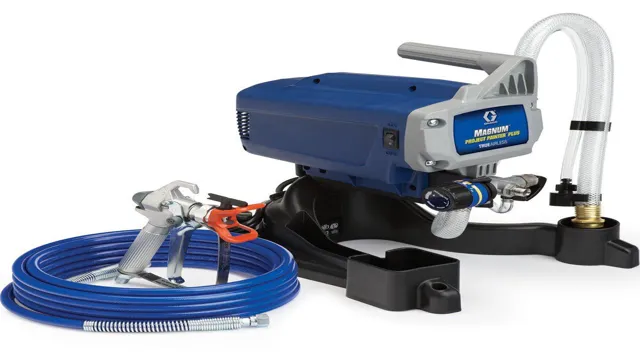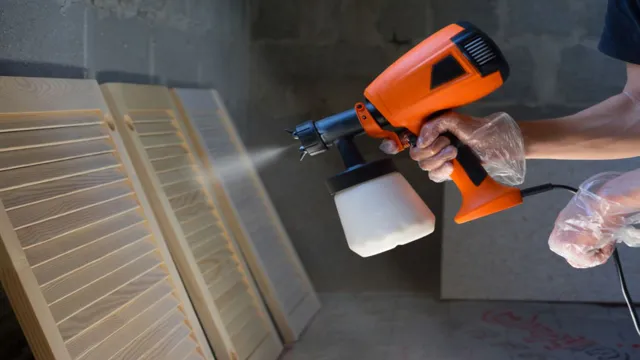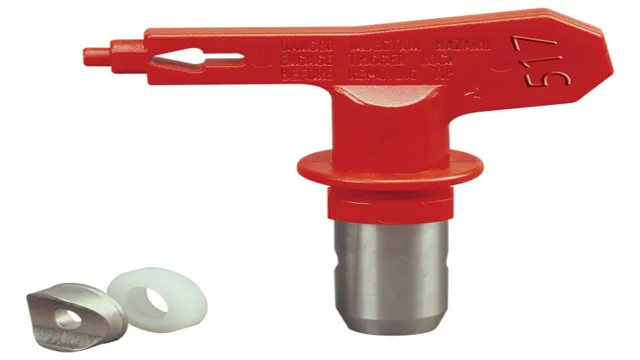Can a Paint Sprayer Be Used Indoors Without Making a Mess? Here’s What You Need to Know.

If you’re considering repainting your indoor walls, you should certainly consider using a paint sprayer. While traditional methods of painting can be time-consuming and messy, a paint sprayer can make your task much easier and efficient. With the right technique and equipment, you can achieve a professional-looking paint job without breaking a sweat.
In this blog post, we’ll go over some tips and tricks to help you tackle your next indoor painting project with a paint sprayer. From choosing the right paint to adjusting the spray settings on your paint sprayer, we’ve got you covered. So, let’s get started!
Understanding Paint Sprayers
If you’re considering using a paint sprayer indoors, the answer is yes, it’s possible. However, there are some precautions you must take to ensure that you don’t create a messy situation or expose yourself to dangerous fumes. Firstly, make sure that the area you’re planning to spray is well-ventilated.
Open up windows and doors to allow proper airflow and use a respirator mask to protect your lungs from fumes. Secondly, cover all surfaces that you don’t want to be painted, like floors, furniture, and fixtures. You can use plastic drop cloths or painter’s tape to protect these areas.
Lastly, maintain a safe distance between you and the surface you’re painting. If you’re too close, the paint may come out unevenly or create drips and runs. Overall, with proper preparation and safety measures, you can use a spray paint indoors and achieve a professional-quality finish that will last.
How Do Paint Sprayers Work?
Paint sprayers are a convenient and efficient way to apply paint to a variety of surfaces. They work by breaking down the paint into tiny droplets and atomizing them into a fine mist. This mist is then sprayed onto the surface, providing an even and uniform coat of paint.
This process is achieved through a combination of pressure, air flow, and fluid control. The paint is stored in a container and fed through a hose to the spray gun, where it is mixed with air and released through a nozzle. The nozzle can be adjusted to control the size and shape of the spray pattern, allowing for greater precision and flexibility.
Overall, paint sprayers are a valuable tool for anyone looking to achieve a professional-quality paint job in a fraction of the time it would take with traditional methods.

Types of Paint Sprayers
Understanding the different types of paint sprayers can be overwhelming for a beginner or even a seasoned DIYer. The three main types of paint sprayers are airless, HVLP, and handheld. Airless paint sprayers use a high pressure pump to atomize the paint, producing a smooth and consistent finish.
HVLP, or High Volume Low Pressure, sprayers use a lower pressure and higher volume of air to atomize the paint, resulting in less overspray and finer detail work. Handheld sprayers are smaller and more portable, making them great for smaller projects like touch-ups or furniture painting. When choosing a paint sprayer, consider your project size and the level of detail you want to achieve.
It’s always a good idea to do some research and read reviews before making a purchase.
Paint Spraying Indoors
If you’re considering painting the interior of your home or office, you might be wondering if it’s safe and effective to use a paint sprayer indoors. The answer is yes, you can use a paint sprayer indoors, but you need to take some precautions to avoid damage to your property and health hazards. First, choose a high-quality paint sprayer that produces fine mist rather than large droplets to prevent overspray and reduce paint waste.
Second, protect floors, furniture, and other items by covering them with plastic or drop cloths. Third, wear protective gear such as a respirator mask, gloves, and goggles to avoid inhaling paint fumes and getting paint on your skin. Finally, provide adequate ventilation by opening windows or using fans to circulate air and dry the painted surface faster.
With these tips in mind, you can create a beautiful and professional-looking paint job without leaving your home or office.
Benefits of Using Paint Sprayers Indoors
When it comes to painting indoors, using a paint sprayer can offer many benefits. One of the biggest advantages is the speed at which the job can be completed. Using a sprayer allows for more even coverage and a faster application, which means less time spent painting and more time enjoying your newly painted space.
Additionally, sprayers can reach tight spaces that brushes or rollers can’t, ensuring complete coverage. Paint sprayers also tend to produce a smoother finish with less visible brush strokes or roller marks. And since the sprayer applies a fine mist of paint, there’s less chance of drips or splatters, making clean-up a breeze.
Overall, using a paint sprayer can save time, provide a more even finish, and make indoor painting a much more efficient and enjoyable process.
Preparation for Indoor Painting with a Sprayer
If you are planning on painting the inside of your home with a sprayer, there are a few things that need to be done in terms of preparation beforehand. First and foremost, it is important to protect your furniture and floors by covering them with drop cloths or plastic sheeting. Additionally, you should remove any fixtures or cover them with tape to prevent them from becoming damaged during the spraying process.
Make sure that all walls are cleaned and free from any dust or debris, as this can affect the quality of the paint job. It is also a good idea to ensure that the room is well-ventilated and that you are wearing proper protective gear such as a respirator mask to avoid inhaling any fumes. Taking these steps can greatly improve the quality of your indoor paint job and ensure that it lasts for years to come.
So, if you want to achieve a professional-looking paint job with a sprayer, take the time to properly prepare your space before beginning.
Safety Precautions While Using a Paint Sprayer Indoors
When it comes to painting indoors, using a paint sprayer can be a quicker and more efficient option than traditional brushes and rollers. However, it’s essential to take the necessary safety precautions to avoid any potential hazards. Firstly, ensure the area you’re working in is well-ventilated.
Open windows and doors or use a fan to circulate the air, as the paint fumes can be harmful if inhaled for a prolonged period. It’s also important to wear protective gear such as goggles, masks, and gloves to prevent any accidental exposure to the paint and to protect your eyes, skin, and respiratory system. Finally, before using the paint sprayer, make sure to read and follow the instructions carefully to avoid any accidents or injury.
By taking these precautions, using a paint sprayer indoors can be a safe and effective way to achieve a professional-looking finish.
Conclusion and Final Thoughts
In conclusion, whether or not a paint sprayer can be used indoors is a bit of a mixed bag. While it certainly can make your life easier by allowing you to cover large areas quickly and evenly, there are some key safety considerations to keep in mind. Make sure you choose a sprayer that is specifically designed for indoor use, wear proper protective gear, and make sure the area is well-ventilated to avoid any potential health hazards.
With these precautions in place, you’ll be able to enjoy a beautifully painted indoor space without putting yourself or others at risk!”
Factors to Consider Before Using a Paint Sprayer Indoors
Paint spraying indoors can be a challenging task, and there are a few factors to consider before starting. The first and foremost factor is the ventilation system in the room. Proper and adequate ventilation is crucial, as paint sprayers release a high concentration of fumes, which can pose a health hazard if inhaled.
Secondly, it is important to cover all surfaces, including floors, furniture, and any other objects in the room to protect them from overspray. Another aspect to think about is the type of paint being used and the surface it will be applied to. Certain types of paints, such as oil-based and epoxy paints, require special precautions like wearing protective gear and using respirators.
Ultimately, it’s important to take all necessary precautions to ensure a safe and successful paint spraying project indoors. By following the appropriate guidelines, you can obtain great results without causing any damage or health concerns.
Wrap Up and Recommendation
In conclusion, paint spraying indoors can be a convenient and efficient way to upgrade the look and feel of your home or workspace. With the right tools and techniques, you can achieve professional-looking results in no time. However, before you start spraying, make sure to take the necessary precautions to protect yourself and your surroundings.
Use a high-quality respirator mask, cover any furniture or items you don’t want to be painted, and ensure good ventilation in the area. It’s also essential to practice using the sprayer on a test surface before tackling the main project. Overall, if you take the time to prepare and follow the correct steps, you’ll be rewarded with a smooth, even finish that will transform your space.
So, why not give paint spraying indoors a try and see the difference for yourself?
FAQs
Can a paint sprayer be used indoors? Yes, a paint sprayer can be used indoors, but it’s important to take into consideration several factors. First and foremost, make sure the room is well ventilated to reduce the risk of inhaling harmful fumes. If the room doesn’t have good ventilation, consider using a respirator mask to protect your lungs.
Additionally, you’ll need to take measures to protect your furniture, floors, and any other items that could be damaged by overspray. Cover them with plastic or drop cloths to prevent any accidental spills. It’s also a good idea to prep the surface before painting by sanding, cleaning, and priming.
This will ensure a smooth, even finish. Ultimately, if you take the necessary precautions, using a paint sprayer indoors can be a quick and efficient way to get professional-looking results.
FAQs
Is it safe to use a paint sprayer indoors?
Yes, it is safe to use a paint sprayer indoors but precautions should be taken such as using a well-ventilated room, wearing a respiratory mask, and covering furniture and floors.
What kind of paint should I use with a paint sprayer for indoor projects?
You can use any type of interior paint with a paint sprayer, just make sure it’s thinned down to the manufacturer’s recommended consistency.
How do you clean a paint sprayer after using it indoors?
To clean a paint sprayer after using it indoors, flush it out with warm water and then run a cleaning solution through it. Make sure to empty all parts of the sprayer and let it dry before storing it.
Can I use a paint sprayer to paint kitchen cabinets indoors?
Yes, a paint sprayer is a great tool to use for painting kitchen cabinets indoors. It will give you an even and smooth finish in a shorter amount of time than traditional painting methods.
Do I need to wear protective gear when using a paint sprayer indoors?
Yes, it’s important to wear protective gear like a respiratory mask and eye protection when using a paint sprayer indoors to avoid inhaling any paint particles.
Can a paint sprayer be used to paint walls indoors?
Yes, a paint sprayer can be used to paint walls indoors and will give you a smooth and even finish. Just make sure to cover any furniture and floors and use a drop cloth if necessary.
How do I troubleshoot a paint sprayer if it’s not working properly indoors?
If your paint sprayer is not working properly indoors, check the filter, nozzle, and hose for any clogs or blockages. Make sure to follow the manufacturer’s instructions for troubleshooting and maintenance.



